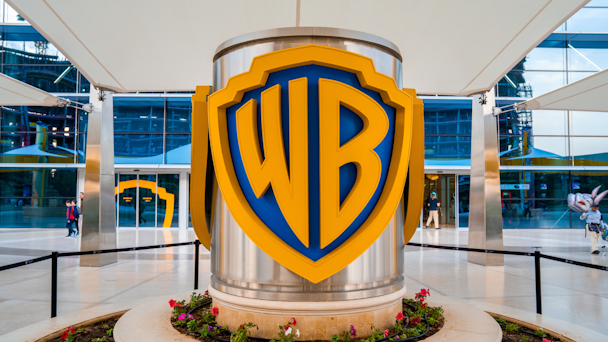New merged HBO-Discovery app Max will see advertisers ‘resoundingly lean in’
The platform will house more content under one roof and bring a wider range of audiences to advertisers willing to pay for premium placements. Media experts believe the move could render Warner Bros Discovery a more formidable challenger to Netflix.

Warner Bros. Discovery is gearing up to take on Netflix in a new way with its bundled Max app / Adobe Stock
Entertainment conglomerate Warner Bros Discovery today confirmed that the company is combining HBO Max and Discovery+ into one unified streaming platform, operating under the new ‘Max’ banner.
“This is our rendezvous with destiny,” said Warner Bros Discover chief executive David Zaslav at a press conference earlier today. “It’s the place that every member of the household can go to see whatever they want at any given time.”
The platform, which will be made available starting May 23, will include a diverse range of content, from the uber-popular drama Succession to reality programming including Dr Pimple Popper and Property Brothers.
It’s a move that some anticipated: two years ago, in the midst of the $43bn merger between WarnerMedia and Discovery, Zaslav reportedly wooed shareholders with the idea that the two empires could create a game-changing connected TV (CTV) streaming app. The deal brought together networks including HBO, CNN, Discovery Channel, Food Network, TLC, Animal Planet, HGTV and more.
Advertisement
But the plan came into question last year, when rumors swirled that Zaslav might sunset HBO Max altogether – and rehouse some of its content in the Discovery+ app – when it was revealed that the platform lost $3bn in 2021 and was removing some programming.
But now, Warner Bros Discovery’s dream of a single powerhouse platform is a reality. It’s a development that many industry players believe will help the conglomerate compete in the increasingly high-stakes streaming wars.
“Max … will pool more content in one offer, which will make it more attractive to viewers,” says Karsten Weide, principal and chief analyst at market research firm W Media Research. “That will make Max more competitive with Netflix and Disney+. It might also save costs by reducing overhead. All in all, this step will make Warner Bros Discovery's streaming business more profitable.”
Of course, not everyone sees it this way. The announcement invited mixed responses from consumers, many of whom derided the name change.
getting rid of the HBO in HBO Max is probably one of the most insane marketing decisions in tv history https://t.co/v9AAjUVVTL
— i want to bailey-ve (@been_herde) April 11, 2023
Some media industry leaders, too, believe that the change could impede the brand‘s success, especially considering the legacy of HBO‘s name, which has become a quality signifier for many. “Getting rid of the HBO name is dangerous. HBO is the most premium name in the TV industry besides Netflix,” says Jeremy Bloom, an adtech expert and entrepreneur who is currently building a networking community for the adtech sector. “‘Max’ reflects Cinemax, and Cinemax is a B-list premium cable network. Bundling Discovery under the Max brand, with HBO, puts a less premium taste in most advertisers’ mouths, along with consumers. Warner Bros Discovery is trying to be everything to everybody, and we all know how that’ll end … This ultimately hurts HBO’s brand.”
The company, of course, defended the decision to drop ‘HBO’ from the service‘s name: “HBO is not TV – HBO is HBO,” said JB Perrette, president and chief exec of Warner Bros Discovery’s global streaming and games, at today‘s press event. “It needs to stay that way, which is why we will privilege it in the product experience and also not push it to the breaking point.”
In spite of the online jeering, it seems media leaders, in general, see the switch-up as a strategic move that could bolster Warner Bros Discovery’s standing in the streaming industry.
“It remains to be seen how things will shake out, but consolidation is not a bad thing in and of itself. In order to compete with the larger streaming services as well as to give more reason to have subscribers stick around, merging two premium brands into one offering makes a lot of sense,” says Hunter Terry, vice-president of solutions consulting and CTV commercial lead at martech firm Lotame.
Advertisement
The advertising appeal
The new service will include three different tiers, which will be in line with current HBO Max pricing, the company said today. The premium ad-free version, which supports four concurrent streams, 4K Ultra HD resolution and 100 offline downloads, will cost $19.99 a month; the ad-free basic version allowing two concurrent streams and 30 offline downloads will go for $15.99; and the ad-supported tier, which allows no offload downloads but supports two concurrent streams, will cost $9.99 a month. (Discovery+ will continue to offer standalone subscription options, but a solo version of HBO Max will no longer be available.)
The tiered structure follows a pattern of similar shifts across the streaming video ecosystem in recent months. In November, Netflix overhauled its subscription offerings and introduced a new ad-supported tier.
Experts believe the trend reflects changes in consumer demand over the last few years. “What is most clear in the CTV space right now is that viewers have an increasing appetite for ad-supported streaming options,” says Tony Marlow, chief marketing officer at LG Ad Solutions. “The announcement of the new Max streaming service could bolster its market position to better compete with other major streaming services already providing content supported by advertising. By offering a diverse content library, a multi-tiered pricing structure, and leveraging popular franchises, Max has the potential to attract a wide range of subscribers and advertisers alike.”
Other industry leaders agree with Marlow’s assessment that Max will create new opportunities for advertisers. “[HBO’s] merger with Warner Brothers, and today’s announcement of Max, is a smart move. Not only does it diversify the content, but audiences alike, which is ultimately what fuels the ad-supported side of the streaming wars,” says Lauri Baker, senior vice-president of strategic partnerships at digital advertising firm Infillion. She says she’s “bullish” on the app’s success and predicts that “advertisers will resoundingly lean in.”
In particular, experts suggest that if the platform can meet advertisers’ increasingly high thresholds for quality, reach and precision, it will be poised to eat up a larger slice of the CTV pie. As Michael Goldstein, head of communications strategy at ad agency DDB North America, puts it: “If Max is able to give advertisers access to high quality, unskippable units, targeted against quality content, then that’s a no-brainer for any large brand.”
Goldstein also points out that HBO’s standard model of “drop-feeding” content – similar to how linear TV networks air ongoing programming – will potentially create value for advertisers by exposing a large, highly-engaged audience to the same ads at the same time. “Through this offering, Max could create multiple mini-Superbowl moments that many brands would be happy to pay a premium on,” he says.
Suggested newsletters for you
Where Max will need to shine
Despite the hype, it’s not necessarily a shoo-in for Warner Bros Discovery with consumers or advertisers, suggests Infillion’s Baker. For one, she says, the user experience needs to be bar-none. “To compete more seriously with Netflix, Disney+ and others, Max will need to not only demand attention from consumers but win at the consumer experience game. UX, inclusive of the advertising experience can make or break a consumer relationship, so I'm hopeful that the WBD team will invest in a consumer-first approach, to match their fan-favorite portfolio of movies & shows.”
And for advertisers? In Baker’s estimation, they won’t settle for anything less than “a premium experience with innovative, cross-screen formats” and top-tier measurement capabilities and insights that help them maximize their returns on ad spend.
And while Max will likely present brands with a range of premium ad offerings, it – and its competitors – have the opportunity to win additional dollars by playing in the smaller spaces, too.
“A lot of the streamers are focusing on the higher end of advertising and big-budget 30-second spots targeted against premium content. Marketers will start to look for smaller more economical opportunities as well,” says Goldstein. These could exist in the user experience ecosystem around the content itself, in the content menu, within the app, in other properties online.”
He says that if any major streaming platform is able to “figure out the ‘messy middle’ of the funnel,” it will be able to expand its appeal among advertisers and stake a larger claim in the market.
For more, sign up for The Drum’s daily US newsletter here.

